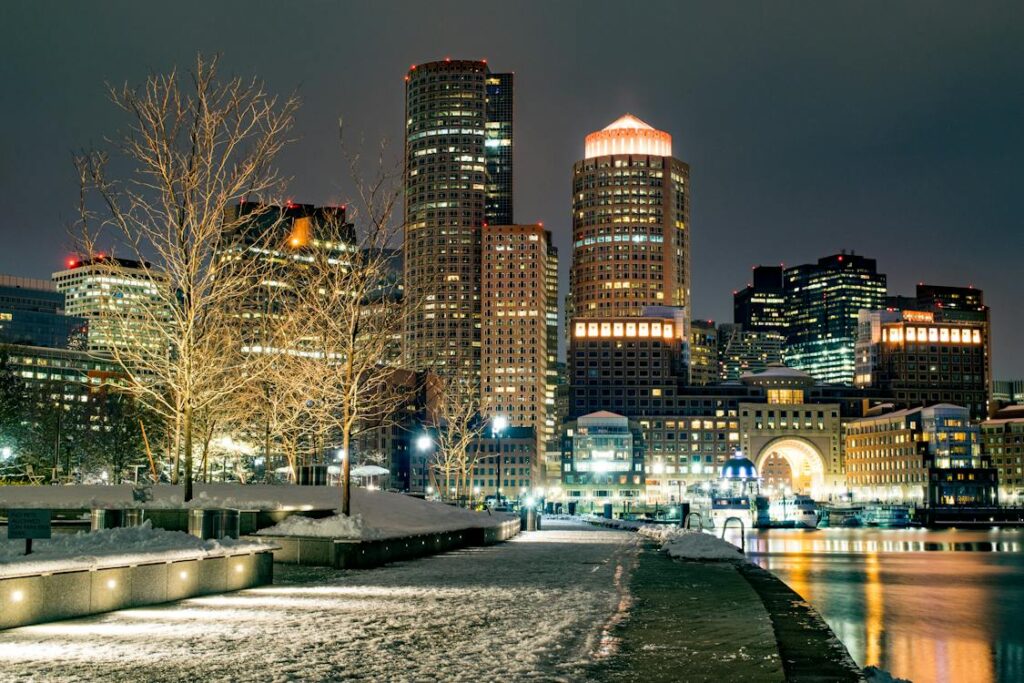
Boston, a city that seamlessly blends its rich historical past with a vibrant, contemporary culture, is a treasure trove of experiences waiting to be discovered. Often referred to as the “Cradle of Liberty,” it’s a place where the echoes of the American Revolution resonate through the cobblestone streets and the majestic buildings.
When considering “Boston places to visit,” one can’t help but be drawn to the deep sense of history that permeates the city. From the iconic Freedom Trail, which weaves through historic sites steeped in the nation’s founding stories, to the modern skyscrapers that punctuate the skyline, Boston is a city of contrasts and convergence.
As a hub of education and culture, Boston is home to some of the world’s most esteemed universities and institutions, which add a youthful vigor and intellectual dynamism to the city. This blend of the old and the new makes “Boston Places to Visit” a diverse and enriching experience.
Whether strolling along the Charles River Esplanade, exploring the bustling streets of Downtown Crossing, or indulging in the culinary delights of the North End, each neighborhood in Boston offers its unique charm and history.
The city’s compact layout makes it an ideal destination for those who enjoy walking, allowing visitors to seamlessly transition from the quaint, historic districts to the trendy, bustling areas, each offering a distinct flavor of Boston’s multifaceted personality.
In this city, history is not just a thing of the past; it’s a living, breathing part of daily life. Bostonians take pride in their heritage, and this is evident in the well-preserved architecture, the numerous historical markers dotting the city, and the stories that local guides enthusiastically share.
When exploring “Boston places to visit,” one gets a palpable sense of being part of the ongoing American story, a narrative that continues to evolve even as it cherishes its beginnings.
Moreover, Boston’s commitment to innovation and progress is evident in its thriving technology sector, world-class universities, and bustling startup scene, ensuring that while it respects its past, it always looks forward to the future.
The Freedom Trail
The Freedom Trail in Boston is a 2.5-mile-long path that takes visitors through 16 historically significant sites, making it a cornerstone of Boston’s rich history. This iconic trail winds from Boston Common to the USS Constitution and Bunker Hill, featuring historic churches, meeting halls, cemeteries, and battlegrounds. Sites like the Massachusetts State House, with its stunning 23k gilded dome, and the Park Street Church, an active church since 1829, are some of the highlights along the trail.
For a deeper understanding of Boston’s history, the Freedom Trail provides a unique educational experience. The Old South Meeting House, significant for its role in the Boston Tea Party, and the Old State House, Boston’s oldest standing building, are not just architectural marvels but also repositories of the city’s revolutionary past.
In addition, sites like the Granary Burying Ground and King’s Chapel Burying Ground offer a glimpse into the lives of historical figures, including John Hancock, Samuel Adams, and Mary Chilton, a Plymouth Pilgrim.
Walking the Freedom Trail is feasible 24/7, but the best time to visit most sites is between 10 a.m. and 4 p.m., Wednesday to Sunday. Many of these sites are managed by independent nonprofits, and while walking the trail is free, some locations may charge admission fees.
Guided tours, often led by guides in historical attire, and self-guided options, like audio tours, are available to enhance the experience.
For families with young children or individuals with mobility concerns, it’s important to note that the trail involves significant walking and crossing busy streets. The Freedom Trail Foundation offers daily history tours, providing a comprehensive understanding of Boston’s pivotal role in American history.
Mapparium
The Mapparium in Boston offers a unique and immersive experience that transports visitors inside a three-story, stained-glass globe. Located inside the Mary Baker Eddy Library, this globe is a representation of the world as it was in 1935. The vivid colors and intricate details of the stained glass create an awe-inspiring visual experience.
As visitors walk across the glass bridge that bisects the globe’s interior, they can view the earth’s surface from an unusual perspective, seeing it from the inside out. This unique vantage point allows for a distortion-free view of the world “from pole to pole,” offering a rare opportunity to see the entire earth’s surface at once.
The Mapparium is not just a visual spectacle; it’s also an acoustical wonder. Known as a “whispering gallery,” its shape creates an unusual acoustic effect where a whisper at one end of the bridge can be heard clearly at the other end as if the speaker were right next to you. This occurs because the Mapparium’s curved glass walls reflect sound waves directly back to their source or carry them around the sphere.
Adding to the experience, an engaging sound-and-light presentation highlights the changes in ideas and geography over time. However, it’s important to note that the political boundaries within the Mapparium have remained unchanged since 1935, offering a glimpse into the geopolitical state of the world before World War II.
The Mapparium is open to visitors with varying hours throughout the year, and admission is required. It’s a popular destination in Boston, providing both an educational and a visually stunning experience for those interested in history, geography, and the unique architectural features of this one-of-a-kind globe.
Visitors can also explore other exhibits in the library that focus on the history of the Christian Science Monitor and the life of Mary Baker Eddy, the founder of Christian Science.
Whale Watching Experience
The whale-watching experience in Boston offers an exciting opportunity to see a variety of whale species in their natural habitat. Some of the most commonly sighted whales near Boston include humpback whales, minke whales, and fin whales, also known as finback whales.
Additionally, visitors might get a rare glimpse of the critically endangered right whales, along with pilot whales, blue whales, sperm whales, and sei whales. These sightings are made possible thanks to the rich marine biodiversity in the area.
The prime whale-watching season in Boston spans from May to October, coinciding with the migration of these majestic creatures to the warm North Atlantic waters for the summer. However, it’s also possible to see whales in March, April, and November.
The best location for whale watching is the Stellwagen Bank Marine Sanctuary, located between Cape Ann and Cape Cod at the mouth of Massachusetts Bay. This federally protected marine sanctuary spans 842 square miles and is an excellent spot for observing whales.
Boston Harbor Cruises, in partnership with the New England Aquarium, offers whale-watching tours that are both educational and exciting. These tours typically last between three-and-a-half and four hours, employing high-speed catamarans to reach the whale-rich areas efficiently.
In addition to whales, these tours also provide the chance to see other marine life such as harbor seals, Atlantic white-sided dolphins, and various seabirds. It’s advisable to wear everyday comfortable clothing with a light jacket, as temperatures can be cooler at sea, even in summer.
For those prone to motion sickness, it’s a good idea to bring motion-sickness medication and focus on the horizon to alleviate symptoms.
Castle Island
Castle Island in Boston is a unique blend of historical significance and recreational activities. Originally the site of a fort erected in 1634, Castle Island is now a popular destination for both locals and tourists.
The main attraction is Fort Independence, an important site that has played various roles throughout colonial and revolutionary times. Visitors can enjoy free tours of the Fort, usually available on weekends, offering a glimpse into the area’s rich history.
Apart from its historical aspects, Castle Island is a hub for various recreational activities. It boasts terrific walkways that are great for activities like rollerblading and walking, with panoramic views of Boston Harbor and Logan Airport, where one can watch planes take off and land.
The island is connected to a string of parks and beaches, providing ample space for sunbathing, swimming, and picnicking. The area is also equipped with picnic tables, benches, and a large playground, making it a perfect spot for family outings. Sullivan’s snack bar is a popular stop for visitors, offering a range of food items including lobster rolls, fries, ice creams, and cold drinks.
For those interested in fishing, there’s a pier where you can catch a variety of fish. The location is accessible with both metered and free parking available along Day Boulevard.
Castle Island’s scenic walkways and its proximity to several beaches like M Street Beach make it an ideal spot for a leisurely day out. The entire area is well-maintained, offering lush green spaces, shaded picnic areas, and refreshing sea breezes, making it a beautiful multi-use park along the water.
Whether you’re interested in exploring a historic site, enjoying a day by the sea, or simply looking for a picturesque spot to relax, Castle Island in Boston is a destination that offers it all.
Isabella Stewart Gardner Museum
The Isabella Stewart Gardner Museum in Boston is a remarkable venue that blends historical architecture with an extensive collection of art. Founded by the philanthropist Isabella Stewart Gardner, the museum opened to the public in 1903 and is designed as a Venetian-style palazzo, featuring three floors of galleries centered around a picturesque interior courtyard.
The collection spans several centuries and continents, including works by renowned artists such as Michelangelo, Raphael, Rembrandt, Titian, Matisse, and Degas. One of the most dramatic pieces in the collection is John Singer Sargent’s “El Jaleo,” displayed in the Spanish Cloister, which was specially designed to house this painting.
The museum is also notable for being the site of one of the biggest art heists in history. On March 18, 1990, thirteen works of art valued at over $500 million were stolen, including Vermeer’s “The Concert” and Rembrandt’s “The Storm on the Sea of Galilee.” Despite this, the museum continues to attract visitors not only for its art collection but also for its architectural beauty.
The skylit courtyard is a highlight, featuring a blend of Roman, Byzantine, Romanesque, Gothic, and Renaissance elements. In 2012, a new wing designed by Renzo Piano was added, providing a contemporary space for artists and exhibitions.
The legacy of Isabella Stewart Gardner as one of the few women of her time to found her museum adds to the allure of this unique Boston landmark.
USS Constitution and Bunker Hill
The USS Constitution, known as “Old Ironsides,” is the oldest commissioned ship in the United States Navy and is still active. Visitors can explore this historic ship at the Charlestown Navy Yard and interact with active duty sailors who serve as interpretative historians.
The USS Constitution is open to the public from Wednesday through Sunday, 10 a.m. to 4 p.m., and admission is free. Visitors over 18 need to present a valid federal or state-issued photo ID for security screening.
The nearby USS Constitution Museum further enriches the visit with interactive exhibits and a collection of artifacts, offering an engaging experience for all ages. The Museum is open daily from 10:00 am to 5:00 pm, and while admission is free, donations are welcome.
A short walk from the USS Constitution is the Bunker Hill Monument, commemorating the first major battle of the American Revolution. Climbing the monument’s 294 steps is a rewarding challenge, providing panoramic views of the city.
The Bunker Hill Museum nearby offers insights into the historic battle. Please note that the Bunker Hill Monument may have unexpected closures through the end of 2023 due to restoration work, and only 20 people are allowed inside at a time. Both the monument and the museum are great educational resources for visitors of all ages.
Beacon Hill
Beacon Hill, one of Boston’s most historic neighborhoods, is a place that seems to have frozen in time, maintaining its 19th-century charm.
This neighborhood is known for its narrow, gas-lit streets and brick row houses with ornate doors and decorative ironwork. It’s home to the Massachusetts State House and many historical landmarks, including the Boston African American National Historic Site. Beacon Hill has a strong community spirit, evidenced by various events and activities organized by the Beacon Hill Civic Association, like the annual Fall Hill Fest and the Centennial Dinner.
In recent times, Beacon Hill has seen several notable developments and events. These include the opening of the Beacon Hill Books store on Charles Street, the ground-breaking ceremony for a new clinical care facility at Massachusetts General Hospital, and various business anniversaries like Blackstones celebrating 40 years.
The neighborhood also witnessed activism, such as the formation of a “human bike lane” by around 150 activists on Charles Street, emphasizing the demand for better cycling infrastructure in the city. These activities and changes demonstrate the neighborhood’s vibrant and evolving character while preserving its historical essence.
Massachusetts State House
The Massachusetts State House, an iconic building in Boston, is renowned for its distinctive golden dome and rich history. It serves as the state capital and seat of government for the Commonwealth of Massachusetts. Designed by Charles Bulfinch, the State House is centrally located in downtown Boston on Beacon Street, at the top of Park Street.
In front of the building, visitors can find statues of historical figures such as General Joseph Hooker, Daniel Webster, educator Horace Mann, and former US President John F. Kennedy. The building’s interior is equally impressive, featuring the Governor’s offices, the Massachusetts Senate, and the House of Representatives.
One unique feature inside the House Chamber is the “Sacred Cod,” symbolizing the significance of the fishing industry to Massachusetts’ early economy.
The Massachusetts State House is not only a hub of political activity but also a place of historical significance. The building’s dome is topped with a gilded, wooden pine cone, symbolizing Boston’s early lumber industry and the state of Maine, which was part of Massachusetts when the Bulfinch section of the building was completed.
The State House is open to visitors Monday through Friday from 9:00 am to 5:00 pm, and while there is no parking available at the site itself, there are several nearby parking options. For visitors with accessibility needs, the Ashburton Park Entrance on Bowdoin Street is wheelchair accessible.
The State House also offers free Wi-Fi, public restrooms on various levels, a cafe, and a state bookstore.
Boston Public Garden
The Boston Public Garden, established in 1837, holds the distinction of being America’s first public botanical garden. This historic garden, known for its decorative and flowery design, is characterized by its winding pathways and variety of plant species.
The Victorian era significantly influenced the garden’s style, featuring vibrant floral patterns and the use of greenhouse-grown plants. George Meacham’s landscape plan, which won a public competition, included many of the garden’s current features like the serpentine pond and winding paths.
Despite some initial criticism for its colorful plant combinations, the garden is now celebrated as one of Boston’s greatest attractions.
Key features of the Public Garden include the famous Swan Boats, operating since 1877, and a variety of statues and memorials, like the Ether Fountain and the equestrian statue of George Washington.
The garden’s maintenance and preservation are managed jointly by the Mayor’s Office, The Parks Department of the City of Boston, and the non-profit Friends of the Public Garden. This partnership has been crucial in restoring and enhancing the garden’s beauty over the years, maintaining its status as a cherished and iconic Boston landmark.
Museum of Fine Arts
The Museum of Fine Arts (MFA) in Boston, one of the largest museums in the United States, holds a diverse and comprehensive collection that makes it one of the most significant art museums globally.
As of 2022, the museum faced several challenges but also achieved notable transitions, including increased visitor comfort and the lifting of capacity limitations. This allowed the museum to expand operations, bring back public programming, and reopen visitor amenities. In FY22, the museum saw an attendance of 632,000, exceeding its budget expectations.
This increase in visitors positively impacted revenue, along with strong membership and philanthropy support. The museum also benefited from additional touring exhibitions and intellectual property revenues.
The MFA’s history dates back to the early 20th century when it moved to its current location on Huntington Avenue in Boston’s Fenway–Kenmore neighborhood. The museum’s building, designed by architect Guy Lowell, opened in stages, beginning in 1909 with a neoclassical design featuring a 500-foot granite façade and a grand rotunda.
Over the years, it has seen several expansions and renovations. The museum’s collection encompasses over 450,000 works of art, including significant holdings in American, Asian, and European art. The museum’s recent expansions include the Art of the Americas Wing and the Linde Family Wing for Contemporary Art, enhancing its capacity to showcase a diverse array of artworks.
Conclusion
In conclusion, Boston, MA is not only a city steeped in rich history and vibrant culture but also a beacon that draws visitors into considering it as their new home. Each of the 10 must-visit places we’ve explored showcases the unique charm and diversity of Boston, from the historic Freedom Trail to the serene Boston Public Garden, and the bustling Quincy Market.
It’s no wonder that long distance movers in Boston report a growing trend of visitors turning into residents. The allure of Boston’s blend of historical significance, cultural richness, and modern amenities has a profound impact on those who wander its streets, making it more than just a stop on a travel itinerary, but a potential place to call home.
Whether you’re a history buff, a culture enthusiast, or simply in love with the idea of city living, Boston offers an array of experiences that resonate with many who visit. So, if you find yourself enamored with the charm of this city during your visit, you’re not alone. Boston is not just a city to explore; it’s a city to live in and love.
Remember, never travel without travel insurance! And never overpay for travel insurance!
I use HeyMondo. You get INSTANT quotes. Super cheap, they actually pay out, AND they cover almost everywhere, where most insurance companies don't (even places like Central African Republic etc!). You can sign-up here. PS You even get 5% off if you use MY LINK! You can even sign up if you're already overseas and traveling, pretty cool.
Also, if you want to start a blog...I CAN HELP YOU!
Also, if you want to start a blog, and start to change your life, I'd love to help you! Email me on johnny@onestep4ward.com. In the meantime, check out my super easy blog post on how to start a travel blog in under 30 minutes, here! And if you just want to get cracking, use BlueHost at a discount, through me.
Also, (if you're like me, and awful with tech-stuff) email me and my team can get a blog up and running for you, designed and everything, for $699 - email johnny@onestep4ward.com to get started.
Do you work remotely? Are you a digital nomad/blogger etc? You need to be insured too.
I use SafetyWing for my digital nomad insurance. It covers me while I live overseas. It's just $10 a week, and it's amazing! No upfront fees, you just pay week by week, and you can sign up just for a week if you want, then switch it off and on whenever. You can read my review here, and you can sign-up here!













 As you know, blogging changed my life. I left Ireland broke, with no plan, with just a one-way ticket to Thailand
and no money. Since then, I started a blog, then a digital media company, I've made
more than $1,500,000 USD, bought 4 properties and visited (almost) every country in the world. And I did it all from my laptop as I
travel the world and live my dream. I talk about how I did it, and how you can do it too, in my COMPLETELY FREE
Ebook, all 20,000
words or so. Just finish the process by putting in your email below and I'll mail it right out to you immediately. No spam ever too, I promise!
As you know, blogging changed my life. I left Ireland broke, with no plan, with just a one-way ticket to Thailand
and no money. Since then, I started a blog, then a digital media company, I've made
more than $1,500,000 USD, bought 4 properties and visited (almost) every country in the world. And I did it all from my laptop as I
travel the world and live my dream. I talk about how I did it, and how you can do it too, in my COMPLETELY FREE
Ebook, all 20,000
words or so. Just finish the process by putting in your email below and I'll mail it right out to you immediately. No spam ever too, I promise!
